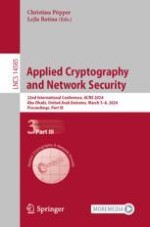The 3-volume set LNCS 14583-14585 constitutes the proceedings of the 22nd International Conference on Applied Cryptography and Network Security, ACNS 2024, which took place in Abu Dhabi, UAE, in March 2024.
The 54 full papers included in these proceedings were carefully reviewed and selected from 230 submissions. They have been organized in topical sections as follows: Part I: Cryptographic protocols; encrypted data; signatures; Part II: Post-quantum; lattices; wireless and networks; privacy and homomorphic encryption; symmetric crypto; Part III: Blockchain; smart infrastructures, systems and software; attacks; users and usability.
